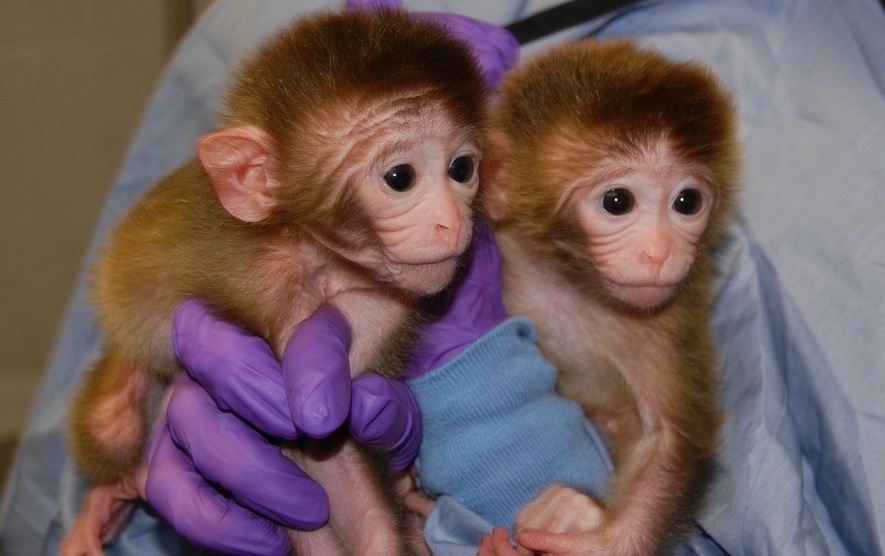Baby Monkeys With 6 Genomes Are Scientific First

They look like ordinary baby rhesus macaques, but Hex, Roku and Chimero are the world's first chimeric monkeys, each with cells from the genomes of as many as six rhesus monkeys.
Until now research on so-called chimeric animals, or those that have cells with different genomes, has been limited to mice; a recent procedure produced mice using cells from two dads.
The researchers turned to monkeys for more insight into the capabilities of embryonic stem cells. Most experiments on stem cell therapies are based on mice, and the researchers wanted to understand whether primate embryonic stem cells respond the same way as those of mice do.
To create the chimeric monkeys, researchers essentially glued together cells from individual rhesus monkey embryos and then implanting these mixed embryos into mama monkeys.
The key was mixing cells from very early-stage embryos, or blastocysts, that consisted of just two to four cells – each one of the cells still totipotent, capable of transforming into a whole animal as well as the placenta and other life-sustaining tissues. (This is in contrast to pluripotent stem cells, which can differentiate into any tissue type in the body, but not certain embryonic tissues or entire organisms.)
"The cells never fuse, but they stay together and work together to form tissues and organs," said Shoukhrat Mitalipov of the Oregon National Primate Research Center at Oregon Health & Science University. "The possibilities for science are enormous." [Images of the Chimeric Monkeys]
Try, try again
Get the world’s most fascinating discoveries delivered straight to your inbox.
The researchers first tried creating chimeric monkeys using the process for chimeric mice. In this procedure, embryonic stem cells are injected into a host embryo after they have been cultured for as long as decades. These stem cells will mix with the host embryo's cells to produce tissues and organs and ultimately offspring. When these offspring are mated, the resulting offspring have cells derived solely from the implanted stem cells. If you were to pluck two cells from a chimeric mouse's body, you could get two different genomes – complete sets of chromosomes and genetic information.
But the methods that work to create chimeric mice failed in rhesus monkeys, leading to offspring with cells only from the host embryo.
"Unfortunately that didn't work," Mitalipov told LiveScience in a telephone interview. "We produced offspring that way and they didn't show any contribution of stem cells." The stem cells seemed to have gotten lost somewhere, he said.
The researchers guessed that the culturing somehow had changed these embryonic stem cells. So they recovered stem cells from an embryo's inner cell mass (rather than from the freezer after being cultured) and, without culturing them, injected the stem cells into a host embryo.
Rather than one chimeric monkey infant, the result was two separate fetuses — twins.
Finally, the researchers hit on a successful method, using early blastocysts that had split into no more than four separate cells. They took individual cells out of these clumps and aggregated them back together, mixing and matching between three and six individuals to create 29 new blastocysts. The researchers picked the 14 strongest-looking of them and implanted them in five surrogate mother monkeys.
All five got pregnant. Researchers terminated the pregnancies of three of them to test the fetuses for chimerism, and they found it. Soon after, the remaining two monkeys delivered twins (named Roku and Hex for the Japanese and Greek words for "six") and a singleton, Chimero. All appear male, though testing on their cells reveals that they also contain individual female genomes.
Growing up chimeric
The monkeys were delivered by C-section. Their mothers rejected them, probably in response to the nonnatural method used to deliver them, so now they are being raised by a foster mama.
Researchers aren't yet sure whether Roku, Hex and Chimero will be able to reproduce. It takes rhesus macaques four to five years to reach sexual maturity.
There are no plans to create human chimeras and no need to, Mitalipov emphasized. This research by itself should help scientists in conducting biomedical research more relevant to humans, he said.
Chimeric mice, for instance, are used to produce genetically engineered "knock-out" mice that carry deletions of important genes. In that way, researchers can see firsthand what genes do or don't do.
The results may be useful in stem cell therapy, Mitalipov said. Researchers believe that stem cells cultured in Petri dishes could be transplanted into adult patients to treat conditions such as paralysis or Parkinson's disease.
"But this is based on mouse models," Mitalipov said. "We didn't know whether primates have this capacity."
The chimeric monkey study, reported today (Jan. 5) in the journal Cell, shows that primate cultured stem cells probably have some potential to differentiate, but they aren't comparable to in-vivo stem cells, or stem cells produced in the body, Mitalipov said.
"We cannot model everything in the mouse," Mitalipov said. "If we want to move stem cell therapies from the lab to clinics and from the mouse to humans, we need to understand what these primate cells can and can't do. We need to study them in humans, including human embryos."
Even though the researchers found success without culturing, cultured cells shouldn't be written off, said Richard Behringer, a geneticist at MD Anderson Cancer Center in Houston. The reason the cells didn't work in monkeys may be due to something in the laboratory process, not because of the cells themselves, Behringer told LiveScience.
"We know so little about the early embryology of our cells," Behringer said. "We know about the fertilization to the blastocyst stage because you can do that in vitro, but after that there's very little known about human embryology — this is when a woman may not even know she's pregnant. Having the monkey model is useful to understand the early embryonic development, where the monkey can stand in for the human."
Follow LiveScience for the latest in science news and discoveries on Twitter @livescience and on Facebook.
Jeanna Bryner is managing editor of Scientific American. Previously she was editor in chief of Live Science and, prior to that, an editor at Scholastic's Science World magazine. Bryner has an English degree from Salisbury University, a master's degree in biogeochemistry and environmental sciences from the University of Maryland and a graduate science journalism degree from New York University. She has worked as a biologist in Florida, where she monitored wetlands and did field surveys for endangered species, including the gorgeous Florida Scrub Jay. She also received an ocean sciences journalism fellowship from the Woods Hole Oceanographic Institution. She is a firm believer that science is for everyone and that just about everything can be viewed through the lens of science.


